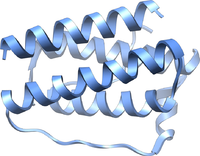
Photo from wikipedia
Objectives: Leptin and adiponectin are adipose-derived immune modulators (adipokines) that may contribute to SLE pathology and symptoms. This study aimed to evaluate the associations of serum adiponectin and leptin with… Click to show full abstract
Objectives: Leptin and adiponectin are adipose-derived immune modulators (adipokines) that may contribute to SLE pathology and symptoms. This study aimed to evaluate the associations of serum adiponectin and leptin with clinical manifestations and disease activity in SLE patients. Methods: This is a case control study, where 70 SLE patients and 50 age- and sex-matched healthy controls were enrolled from the Rheumatology and Rehabilitation Department of Beni-Suef University Hospital from June 2020 till April 2022. The SLE disease activity index (SLEDAI) and Systemic Lupus International Collaborative clinics/America Collage of Rheumatology damage index were used to assess disease severity. Laboratory parameters including erythrocyte sedimentation rate (ESR) and serum concentrations of antinuclear antibody (ANA), anti-double stranded DNA, complement 3 and 4, lipids, and C-reactive protein (CRP) were measured and compared between SLE and control groups. Serum adiponectin and leptin were also measured by enzyme-linked immunosorbent assays (ELISA). Results: Compared to healthy controls, SLE patients exhibited significantly greater serum leptin (21.1 vs 3.9 ng/mL, p < 0.001) and adiponectin (18.1 vs 4.8 ng/mL, p < 0.001), and both values were positively correlated with SLEDAI scores (p = 0.048 and 0.042). Higher serum leptin was significantly associated with lupus nephritis (LN) (p = 0.048) as well as greater body mass index (p = 0.010), ESR (p = 0.002), serum CRP (p = 0.003), total cholesterol (p = 0.013), and uric acid (p = 0.002), while higher adiponectin was significantly associated with LN (p = 0.046). Conclusion: Serum leptin and adiponectin levels are associated with the clinical and pathological manifestations of SLE, suggesting direct involvement in disease progression and utility as diagnostic biomarkers and therapeutic targets.
Journal Title: International Journal of Immunopathology and Pharmacology
Year Published: 2023
Link to full text (if available)
Share on Social Media: Sign Up to like & get
recommendations!